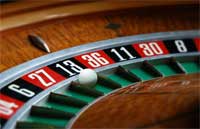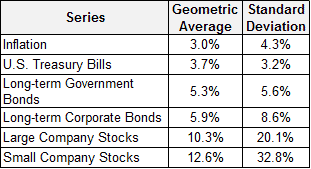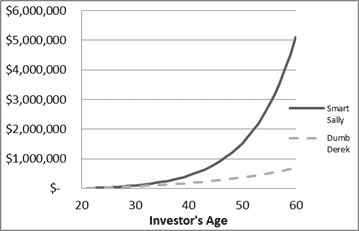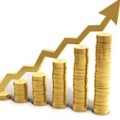The following is an excerpt from my book Stock Market Investing for Newbies. If you would like to learn more about stock market investing but don’t know how to get started, why not pick up a copy of my book today?!?
Now that we have a better understanding of inflation and how compound interest works, we’re ready to get down to business. Let’s talk about what type of return on your investment you can expect out of the stock market over the long run.
What extra rate of return can we expect to earn by putting our money at increased risk in the stock market?
Before we can answer that question, I need to lay a little more groundwork. The primary thing to keep in mind is that risk is NOT necessarily bad! From a young age, most of us are trained to minimize risk. “No running, wear your helmet, don’t do that – it’s not safe” were probably all things that we heard as kids. When it comes to personal safety, reducing risk is good. But, taking on calculated financial risk is usually necessary to gain rewards.
We know the old adage: “Higher risk equals higher reward?” As you will learn in this book, this is exactly how the stock market works.
Think of investments as one big spinning roulette wheel (the kind that you’d would find in Vegas). The payout if you place a bet on double-zero is much higher than if you place a bet on red (35-to-1 vs. 1-to-1 odds). Likewise, the odds of hitting a double-zero are much lower than the odds of hitting a red. With roulette, the house has an edge of a little more than 5%. This means that if you play roulette long enough, you will eventually lose all of your money because the house will always win over the long run.
What are the long term odds of investing in the stock market?
Would you be surprised to find that the odds are actually stacked in your favor? Unlike gambling, if you invest intelligently in the stock market long enough, the historical odds indicated that you will come out way ahead. What do I mean about “intelligently” investing in the stock market?
Let’s say you are in are Vegas, knocking back the drinks and having the time of your life. You just placed a sizeable bet on double-zero and won! Congratulations – how lucky! Now, what if you decided to bet continuously only on the double-zero (high risk bet)? What do you think would happen? You would most likely run out of money after only two or three more spins.
In Figure #1 below, the historical average return for different types of investments is presented. This represents annual historical returns from the period of 1926 – 2005. These investments are ranked from lowest average return to highest average return. What does Figure #1 indicate?
Figure #1 – Average Rates of Return for Various Investments
If you are particularly observant you will see that as the average rate of return increases, the standard deviation also increases. Why is this so important for us to understand?
It works very much the same way when investing in the stock market. If you put “all of your eggs in one basket,” you stand a very high chance under-performing the majority of investors. Sure, there is that chance that you may strike it rich with a couple of lucky bets just like that roulette wheel double-zero bet; but, over the long run you’re much more likely to lose most of your money if you focus on extremely high-risk bets.
Without getting too complicated, the standard deviation is basically a measure of the variability in a process (in our case annual stock returns). Higher standard deviation numbers mean that the annual return for an investment is hard to predict and could bounce all over the place. If an investment return is hard to predict year to year, it is said to be more risky.
Figure #1 tells us that higher risk investments will carry a higher average return over the long run. Why is this the case? Because investors demand a higher potential payout as their investments become more risky.
Let’s go back to our roulette wheel example – would people ever place a bet on double zero if the payout were only 2 to 1? Of course not!! Burn this concept into your memory. It is the most important concepts in all of investing: higher risk is necessary for the potential of higher return.
Standard Deviation and Stocks
As mentioned earlier, the standard deviation is a number that describes how variable the likely outcome return can be for each year. Larger numbers mean that you could win big, or you could lose big year-to-year. Let’s take “Small Company Stocks” as an example. Figure #1 tells us there is a 68% chance (the definition of a standard deviation) that the annual return on investing in small company stocks could be anywhere between plus or minus 32.8%. It is great if you happen to have a +33% year, but it isn’t so fun if you have a -33% return year. However, over the 80 year period on which the figure is based, you can expect an average annual return of 12.6%!
This works great if you can put your money into small company stocks and not touch it for an extended period of time. The same sort of logic applies to investing in long-term government bonds. The percent swing in annual returns is much lower (only a 5.6% amount for one standard deviation), but you stand to earn a whole lot less over time by investing in these much more conservative instruments (only 5.3% annually).
Have you ever heard the advice that you should take higher risk when you’re young and then move into low risk investments as you get older? This principle is based on the standard deviation of the annual return. Think about it – why would you invest in something that gave you only a 5.3% annual return when you could get a 12.6% return?
Well, let’s say you’re 65 and you’ve saved up a ton of money in your investing account ($1,000,000 just to make the math easy). You’ve left everything in the most risky “bucket” – small company stocks. Now, the market decides to teach you a lesson and your stocks drop 33%. You just lost more than $300,000! Sure, you may get it back, but you might die before that happens. You are old, remember?
Alternatively, let’s say that when you were 60 years old your small company stocks had a great year. At that point, you decided to move almost everything over into long-term government bonds. Now, if things do not go your way, you might lose 6% in one year. This is not that big of a deal because you only took a paper loss of $60,000. You’ll probably have time to make that smaller amount back over time. In this way, you will not be adversely affected by a market downturn at the very time you want to retire.
Take Risk When You Are Young
The same idea also works in reverse. If you are young (let’s say in your teens, twenties, or early thirties), then the best place for you to invest is in high risk assets like small company stocks. If you have a couple of bad years (like in 2008 – 2009), that is OK. You have 20-40 years to make it all back. Remember, the long term rate of return is ~12.6%.
Figure #2 – Investment Account Value at Various Ages (Smart Sally invests in Small Company Stock with 12.6% annual return, Dumb Derek invests in Long-Term Government Bonds at 5.3% annual return)
Figure #2 is an over-simplification, but it illustrates the point made above. Let’s say we have two people – Smart Sally and Dumb Derek (again, no relation). They are both 20 years old, and they are both careful savers. Both are able to put aside $5,000 a year to invest. Smart Sally has read this book, and she knows the long term rate of return for investing in small company stocks far outweighs more conservative investments. Dumb Derek decided not to read this book even after all of the praise and acclaim it has received. Dumb Derek heard all of the stories about how people lost wheel barrels full of money in the dot-com crash and the 2008 financial crisis. He decides to just invest in the safe bet – long-term government bonds. Just look at what happens.
At age 60, Smart Sally has a retirement fund of more than $5,000,000 dollars. Dumb Derek’s retirement account only has a value of less than $700,000. Now obviously, there will be many ups and downs with their investments over time. This is not shown in the above figure just for simplicity and understanding. Also, you would be pretty crazy to have 100% of your portfolio in small company stocks as you near retirement age. The smart thing would be to slowly convert you investments over to more conservative assets as you get older. However, I hope you can see that taking an educated approach by accepting calculated risk can really be to your advantage when it comes investing in the stock market – especially when you are young!
What Are Typical Stock Market Investing Results – Final Thoughts
As you can see, higher risk is necessary for the potential of higher return! We will discuss in more detail, in later posts, how you can take types of “smart” risks in the stock market. There are methods that you can easily employ to increase your annual investment returns without increasing your risk substantially. You can even employ some easy methods to increase returns by actually taking on less risk!












Nice explanation of the stock market. It is essential to invest in the market if you want any chance of having enough money for retirement. If you just keep everything in cash, you are barely keeping up with inflation which means if you need $1 million for retirement you need to actually save $1 million. With the stock market you can save much less and let compound interest work its magic.
Yes – it took me a good while to realize this. It’s pretty common sense, but I think it is surprising how many do not really understand this concept!